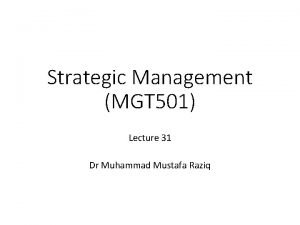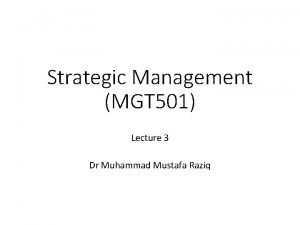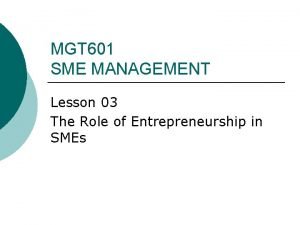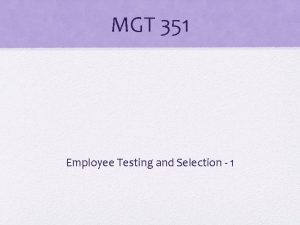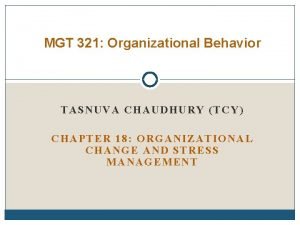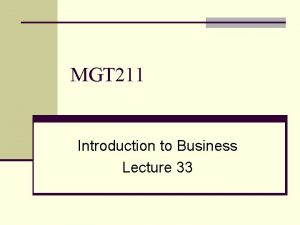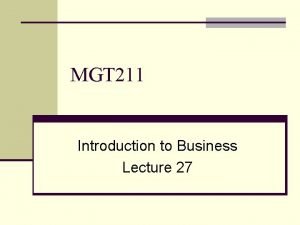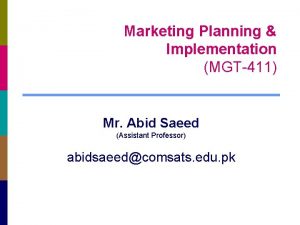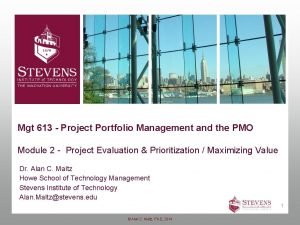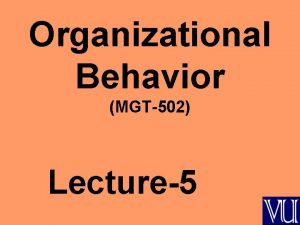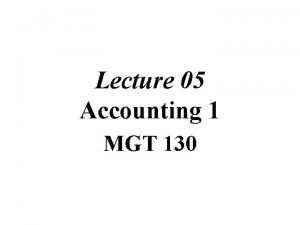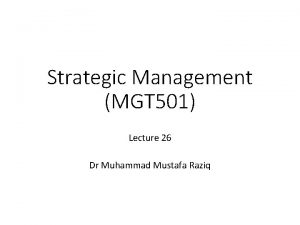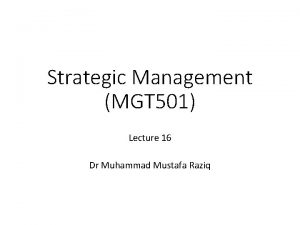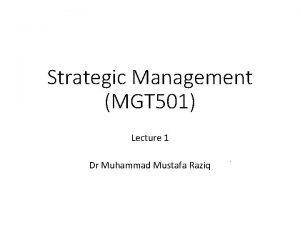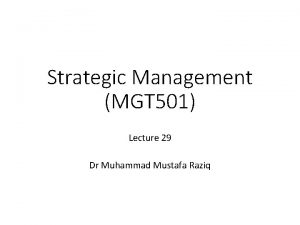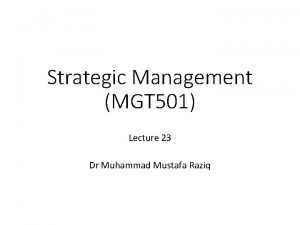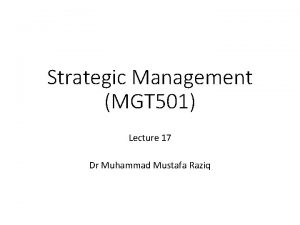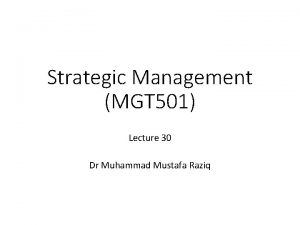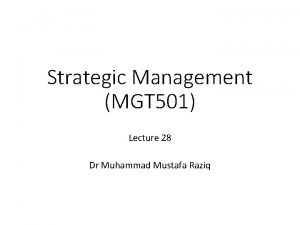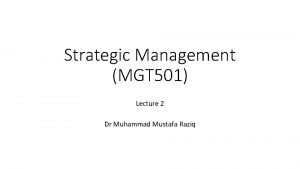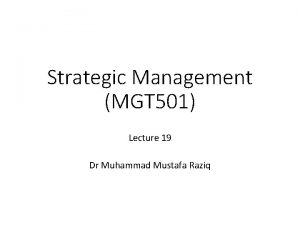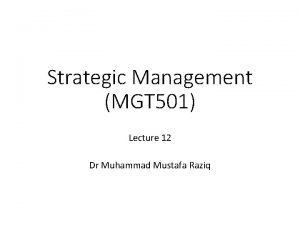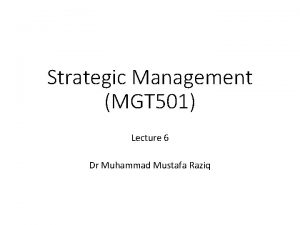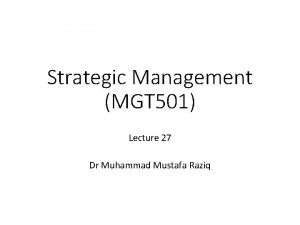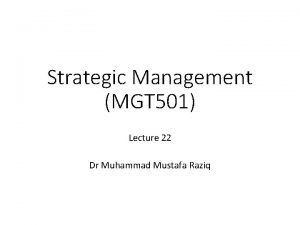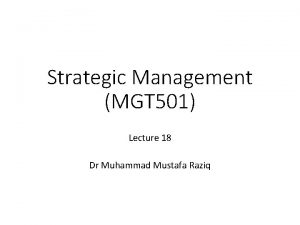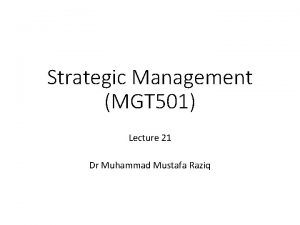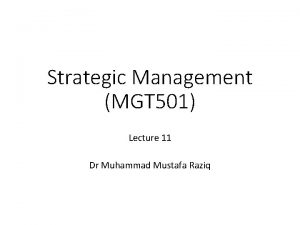Strategic Management MGT 501 Lecture 24 Dr Muhammad





















- Slides: 21

Strategic Management (MGT 501) Lecture 24 Dr Muhammad Mustafa Raziq

Topic Covered in the Previous Lecture • Strategic Alliances • Joint Venture’s Strategies • International Business Entry Level Strategies

Topics to be covered in this lecture • Political Strategies for Competitive Advantage • Reverse Logistics as Sustainable Competitive Advantage • Outsourcing Strategies: Make versus Buy • Franchising Strategies • Portfolio Analysis • Strategic Management in a Strategic Business Unit

6. 8. Political Strategies for Competitive Advantage • Various political tactics such as lobbying, advocacy advertising, constituency building, financial contributions, coalition formation, and supporting nationalists causes are undertaken by firms to influence the political environment • Traditionally, firms viewed government as a necessary evil or an institutional constraint on a firm rather than a set of opportunities • Strategic political management means a set of strategic actions that firms plan and enact for the purpose of maximizing economic returns from the political environment • Usually firms engage in political strategies to create or maintain their value

6. 9. Reverse Logistics as Sustainable Competitive Advantage • Product returns from retailers and customers to the manufacturers are becoming a fact of life and overall customer returns are estimated to be at 6% of sales and may be as high as 15% for mass merchandisers • The traditional value chain starts from the inbound logistics and ends with service, which is one directional flow of primary activities • However, innovative companies begin to extend their distribution channels beyond the end customers to include the acceptance and disassembly of final products for reuse and reanalysis. • Finally, transforming the returned products into new tangible and intangible values. • Reverse logistics is the process of planning, implementing and controlling the efficient flow of materials, finished goods, inventory and related information from the point of consumption to the point of origin for the purpose of recapturing value or proper disposal (Rogers and Tibben-Lembke, 2001)

6. 9. 1. Reverse Logistics Drivers • There are financial, social, and environmental drivers of reverse logistics offering advantages to a firm. Recovery is cheaper than building or buying new materials • Recoverable and return processing manufacturing systems are not only environmentally friendly and profitable but also improves customer loyalty • Proper disposal of returned products can create customer loyalty. Products recovery offers competitive advantage to a firm when customers perceive that they can return an item if it does not function properly or its use period is over, thus enhancing the image of the firm resulting in customer loyalty.

6. 9. 2. Developing Reverse Logistics as Strategic Capability • Handling reverse logistics process is a strategic capability starting from customer return collection to feed different parts of the primary activities of the value chain • Remanufacturing, reassembling, reconditioning, disassembling, and reusing of the components from the used product are capabilities that are being developed by firms • After disassembling, the usable components from the returned products are mixed with new raw materials in a remanufacturing process • Through remanufacturing, feeding most parts of the collected used products to the outbound logistics is a strategic capability for a firm, to be developed as an integral part of the business model, to derive the sustainable competitive advantages

6. 10. Outsourcing Strategies: Make versus Buy • Outsourcing is a decision by the firm not to make a product or service internally but to purchase it externally • Sourcing inputs has evolved into a strategic process for firms. Sourcing was originally limited to procurement of materials and resources. Now, even core functions such as engineering, R&D, manufacturing, and marketing can be moved outside the boundary of the firm, retaining only the control, but not ownership. • How to source every single activity in the value chain in the most competitive manner has emerged as capability sourcing

6. 10. 1. Benefits of Outsourcing • After determining which capabilities or functions that offer the highest potential value from outsourcing, it is necessary to assess how efficiently each function is performed • If the cost per transaction is above industry median and company’s ability to perform a function is not good enough, such a function is to be outsourced for better results. • In an outsourcing decision, it is normal to explore whether such an activity can be carried out at a distance without any loss of quality and without affecting the process. • If an activity, if imitated by rivals, could damage the firm, then such an activity is not a candidate for outsourcing.

6. 10. 1. Benefits of Outsourcing (continued) • The benefits of outsourcing are as follows: • Enables the firm to focus on activities for which it has superior competence and to outsource the rest • Outsource function from other firms that are most efficient in that function, thereby reducing cost. • Firms get opportunities to differentiate based on their core competences • Opportunity to create new businesses, adjacent to core business • Risk reduction from changing technologies • Start new projects faster

6. 11. Franchising Strategies • Franchising is a method of business growth where the firm sells its brand name in return for a franchising fee and adopting standardized systems and procedures that will not dilute the brand image • The franchisee is an investor who sets up the shop with his/her own capital in the brand name of the franchiser and runs the business. • There are basically two forms of franchising with a third hybrid form as it evolved now: • Product distribution franchising • Business format franchising: an ongoing business relationship that covers the product, service, trademark, and the entire business concept with a continuous process of assistance, guidance, and supervision. This is an incubator of a small businesses • Hybrid concepts that are minimum guarantee models

6. 12. Portfolio Analysis • The portfolio of products, projects or entrance into new ventures or business is assessed primarily on the estimated value creation potential. Thus, the profitability or value creation from the new venture should exceed the cost of capital • The cost of capital is calculated as the sum of riskfree rate of return and risk premium (high level of return by assuming risk of investment options)

6. 12. Portfolio Analysis (continued) • The sources of value creation while considering diversification, alliance, acquisition, or partnership opportunities are as follows: • • • Economies of scale opportunities Product differentiation Cost advantage due to learning curve Proprietary technology or innovation Monopoly control of low-cost raw materials Access to distribution channels Entry in regulated markets with new technology Government protection to a business Redefining a market New customer or societal need creation or identification

Chapter 7: Business Level and Functional Strategies

7. 1. Strategic Management in a Strategic Business Unit • A SBU is a profit center that focuses on product offering and a market segment • Corporations are likely to be composed of many SBUs each having its own marketing plan, analysis of competition, and profitability goals.

7. 1. 1. Structuring into SBU for Competitive Advantage • An already existing company may be reconfigured or restructured into two or more SBUs based on any of the following criteria of forming SBUs: • Administrative elements • Operational elements • Market elements • The firm should define the role of an SBU within the firm, before embarking on setting up one, as there should be value logic. • Restructuring into SBU should give superior performance to the firm compared with the monolithic organizational structure that is based on centralization, formalization, and complexity.

7. 1. 1. Structuring into SBU for Competitive Advantage (continued) • An SBU operates similar to a smaller company where the big complex task of managing a big company is divided into smaller groups of tasks to reduce the complexity • This reduction in complexity by reorganizing into SBUs gives strategic benefits if the criteria used are appropriate and the SBU has autonomy in right measure from the corporate headquarters

7. 1. 2. Benefits of a SBU • An SBU helps primarily in tracking investments against returns and reduces complexity. The type of investments needed for each product, portfolio of brands, a territory, or market segment can be decided, implemented, and monitored separately. • Other benefits of SBU are as follows: • An SBU enables its management to be in touch with the market, collects feedback, and takes decisions for correct position in the market or market segments of the SBU • An SBU enables focus on each and every product of a multi-product company or focus a market segment

7. 1. 2. Benefits of a SBU (continued) • The SBU level strategy gets implemented through operational strategies or functional strategies. It is easier to change the strategy and structure at SBU level compared with a structural change at the corporate functional level. • It is also important to have a fit between the back-end operational strategy and the front-end strategy at the SBU level. • Whenever a change is made in the strategy at the SBU level, the SBU structure should be adjusted to fit with the changed strategy and the operational strategies also need to be changed for alignment or strategic fit.

Summary of the topics covered in this lecture • Political Strategies for Competitive Advantage • Reverse Logistics as Sustainable Competitive Advantage • Outsourcing Strategies: Make versus Buy • Franchising Strategies • Portfolio Analysis • Strategic Management in a Strategic Business Unit

Topics for the next lecture • Stability Strategies • Growth – Horizontal and Vertical • Divestment • Human Resource Strategies
 Mgt 501
Mgt 501 Mgt 501
Mgt 501 Mgt 501
Mgt 501 Wa ta izzu man tasha in arabic text
Wa ta izzu man tasha in arabic text Sami allahu liman hamidah meaning
Sami allahu liman hamidah meaning Strategic management lecture
Strategic management lecture Io model strategic management
Io model strategic management Strategic analysis and choice in strategic management
Strategic analysis and choice in strategic management 01:640:244 lecture notes - lecture 15: plat, idah, farad
01:640:244 lecture notes - lecture 15: plat, idah, farad Mgt 323
Mgt 323 Discuss the scope of management accounting
Discuss the scope of management accounting Mgt 601
Mgt 601 Mgt 351 nsu course outline
Mgt 351 nsu course outline Mgt340 group assignment
Mgt340 group assignment Mgt 321 chapter 1
Mgt 321 chapter 1 Mgt 211
Mgt 211 Mgt 211
Mgt 211 Mgt 411
Mgt 411 Mgt 385
Mgt 385 Ecv expected commercial value
Ecv expected commercial value Mgt 502
Mgt 502 Mgt 130
Mgt 130
